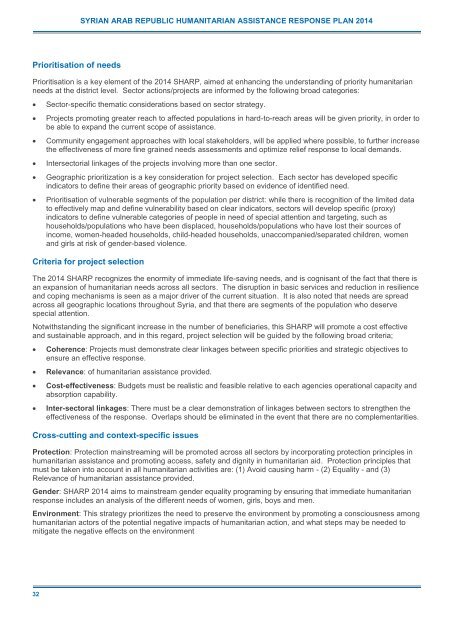2014 Syrian Arab Republic Humanitarian Assistance Response Plan (SHARP)
- No tags were found...
Create successful ePaper yourself
Turn your PDF publications into a flip-book with our unique Google optimized e-Paper software.
SYRIAN ARAB REPUBLIC HUMANITARIAN ASSISTANCE RESPONSE PLAN <strong>2014</strong><br />
Prioritisation of needs<br />
Prioritisation is a key element of the <strong>2014</strong> <strong>SHARP</strong>, aimed at enhancing the understanding of priority humanitarian<br />
needs at the district level. Sector actions/projects are informed by the following broad categories:<br />
<br />
<br />
<br />
<br />
<br />
<br />
Sector-specific thematic considerations based on sector strategy.<br />
Projects promoting greater reach to affected populations in hard-to-reach areas will be given priority, in order to<br />
be able to expand the current scope of assistance.<br />
Community engagement approaches with local stakeholders, will be applied where possible, to further increase<br />
the effectiveness of more fine grained needs assessments and optimize relief response to local demands.<br />
Intersectorial linkages of the projects involving more than one sector.<br />
Geographic prioritization is a key consideration for project selection. Each sector has developed specific<br />
indicators to define their areas of geographic priority based on evidence of identified need.<br />
Prioritisation of vulnerable segments of the population per district: while there is recognition of the limited data<br />
to effectively map and define vulnerability based on clear indicators, sectors will develop specific (proxy)<br />
indicators to define vulnerable categories of people in need of special attention and targeting, such as<br />
households/populations who have been displaced, households/populations who have lost their sources of<br />
income, women-headed households, child-headed households, unaccompanied/separated children, women<br />
and girls at risk of gender-based violence.<br />
Criteria for project selection<br />
The <strong>2014</strong> <strong>SHARP</strong> recognizes the enormity of immediate life-saving needs, and is cognisant of the fact that there is<br />
an expansion of humanitarian needs across all sectors. The disruption in basic services and reduction in resilience<br />
and coping mechanisms is seen as a major driver of the current situation. It is also noted that needs are spread<br />
across all geographic locations throughout Syria, and that there are segments of the population who deserve<br />
special attention.<br />
Notwithstanding the significant increase in the number of beneficiaries, this <strong>SHARP</strong> will promote a cost effective<br />
and sustainable approach, and in this regard, project selection will be guided by the following broad criteria;<br />
<br />
<br />
<br />
<br />
Coherence: Projects must demonstrate clear linkages between specific priorities and strategic objectives to<br />
ensure an effective response.<br />
Relevance: of humanitarian assistance provided.<br />
Cost-effectiveness: Budgets must be realistic and feasible relative to each agencies operational capacity and<br />
absorption capability.<br />
Inter-sectoral linkages: There must be a clear demonstration of linkages between sectors to strengthen the<br />
effectiveness of the response. Overlaps should be eliminated in the event that there are no complementarities.<br />
Cross-cutting and context-specific issues<br />
Protection: Protection mainstreaming will be promoted across all sectors by incorporating protection principles in<br />
humanitarian assistance and promoting access, safety and dignity in humanitarian aid. Protection principles that<br />
must be taken into account in all humanitarian activities are: (1) Avoid causing harm - (2) Equality - and (3)<br />
Relevance of humanitarian assistance provided.<br />
Gender: <strong>SHARP</strong> <strong>2014</strong> aims to mainstream gender equality programing by ensuring that immediate humanitarian<br />
response includes an analysis of the different needs of women, girls, boys and men.<br />
Environment: This strategy prioritizes the need to preserve the environment by promoting a consciousness among<br />
humanitarian actors of the potential negative impacts of humanitarian action, and what steps may be needed to<br />
mitigate the negative effects on the environment<br />
32



